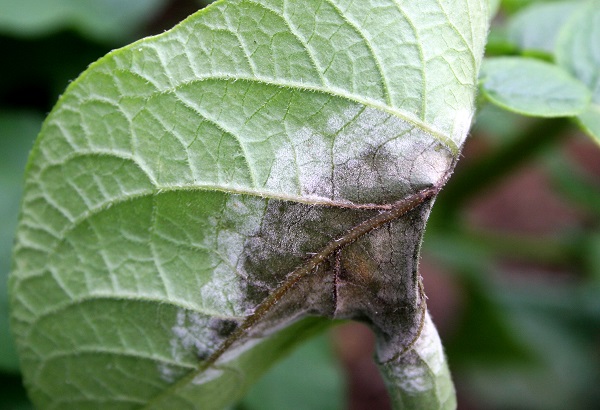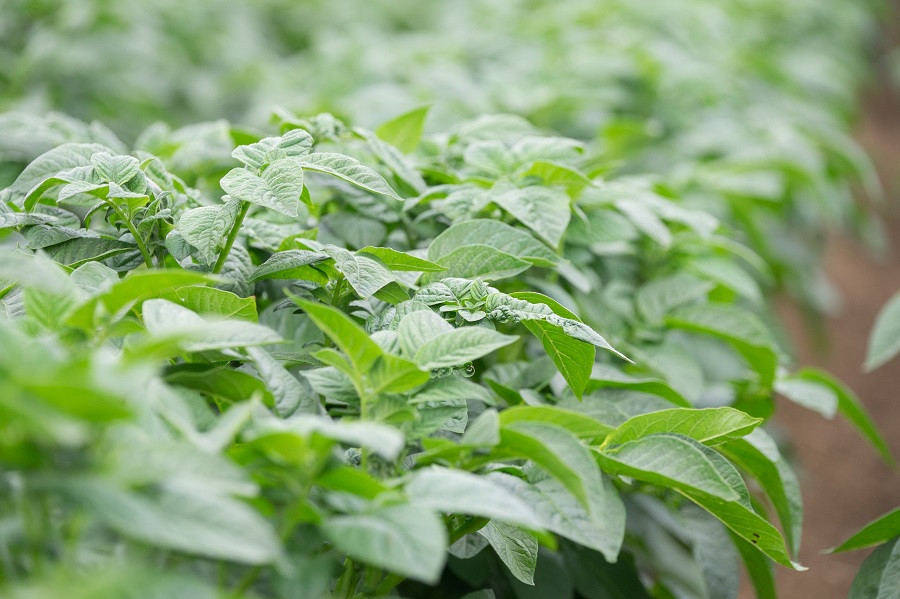A drift retardant is proving to be a knight in shining armour by giving fungicides a bit more help in the battle against late blight. CPM finds out how it is supporting the crusade against blight.
Full crop coverage is vital to prevent scattered infection.
By Lucy de la Pasture
Blight has always been a challenging disease, but since the Phytophthora infestans population changed dramatically in 2006, the fight against blight has become increasingly confronting.
“Keeping late blight out of potatoes is a season-long campaign for growers and one that seems to be getting tougher as the years go by, with seven-day spray intervals now standard practice” says Stuart Sutherland, technical manager for adjuvant specialists, Interagro, with 10-14 day intervals now confined to a previous era when blight wasn’t as aggressive.
AHDB has responded to the challenges presented by these new blight strains by producing extensive guidance to the industry on resistance management strategies for late blight, co-written by SRUC’s Dr Ruairidh Bain and ADAS’ Dr Neil Paveley and Dr Faye Ritchie.
The guidelines specifically highlight the drift retardant Crusade for inclusion in blight programmes after work carried out at SRUC over a number of seasons showed improved control when it is applied with blight chemistry. So how do its drift-retardant properties help?

As blight becomes even more aggressive, getting the most out of blight chemistry is important to protect the crop and for resistance management.
“With resistance to fluazinam now established in the blight population and a continuing shift towards more aggressive P. infestans populations, such as 36_A2 and 37_A2, a robust resistance management strategy is essential to safeguard both crops and blight chemistry.”
Part of making any blight programme ‘robust’ is achieving good coverage of the foliage throughout the canopy with blight sprays, explains Stuart. With this is mind, Interagro set out to develop a spray solution that would address some of the practical problems growers face and give them more flexibility in their blight programmes by supporting the performance of a range of different active ingredients. It was an ambitious target but resulted in the innovative product, Crusade.
This is a flexible drift retardant specifically designed for use with all potato blight fungicides to reduce drift and maximise fungicide coverage in all parts of the crop canopy, explains Stuart. Keeping spray intervals tight is a practice that growers have become familiar with, but it isn’t without its challenges when unfavourable conditions can mean spray days are few and far between.
“Drift is the biggest cause of off-target chemical movement and increases the threat to the crop from late blight where it’s not adequately protected. Crusade reduces drift, which in turn ensures the full intended dose is delivered to the whole crop in order to maximise fungicide performance,” he explains.
“By delivering the intended fungicide dose to the crop, Crusade assists the fungicide in providing stronger protection against blight in situations where it otherwise would have been compromised by drift.”
The canopy structure of the potato crop provides an additional challenge when it comes to delivering blight fungicide to the lower leaves. “While full crop coverage with a fungicide is vital to prevent scattered infection, the ‘umbrella-like’ structure of the canopy – a series of interlocking leaves – makes this very difficult to achieve.
“Leaves are good collectors of vertical moving spray in the upper canopy but the leaves and stems lower down in the canopy can be very hard to reach, increasing the risk of tuber blight.”
So how does Crusade help the distribution of the spray within the canopy? Stuart explains that the drift retardant works by manipulating the droplet size. By increasing the proportion of spray droplets in the ‘optimum’ size category for drift reduction and target leaf retention, spray coverage is maximised and therefore so is the fungicide dose.
“Droplets can’t be too big because they’ll bounce off the leaf and miss the target nor too small, which means they may evaporate and drift off-target. They have to be just right. Crusade creates droplets more capable of reaching the upper and lower canopy and significantly reduces the number of fine spray droplets, smaller than 100 microns, that are the most susceptible to drift. In turn this effect increases the spray angle uniformity at the nozzle, helping ensure the correct dose is applied to the target,” explains Stuart.
Some of the challenges posed by the rapidly changing weather that characterises the climate in the Scottish Highlands, particularly along the Black Isle coast, has led Agrii agronomist John Mason to include Crusade routinely in his blight programmes.
“The windows for blight spraying in Inverness-shire mean spray intervals either have to tighten because rain is coming or where a seven-day interval is maintained, there’s a risk rain soon after will spoil the programme,” he explains.
John looks after potatoes being grown for the local ware market, as well as crops being grown for first-generation and pre-basic seed. As with all products he recommends, he looks for ways to maximise efficacy and with blight control this is absolutely crucial.
His blight programmes begin early doors, typically starting with Lieto (zoxamide+ cymoxanil) or Profilux (cymoxanil+ mancozeb) at the rosette stage, as soon as there’s a target big enough to hit.
“Then I’ll follow with Versilus (benthiavalicarb) plus mancozeb before bringing in products with systemic activity such as Axidor (cymoxanil+ propamocarb) and Zorvec Enicade (oxathiapiprolin), alternating modes of action through the rapid and stable canopy stages for resistance management.”
Typically John achieves this by using products from the different fungicide groups – carboxylic acid amides (CAA), which include Dimix (dimethomorph) and Versilus; Lieto from the benzamide group and Percos (ametoctradin+ dimethomorph), which contains actives from the Quinone outside Inhibitor, stigmatellin binding type (QoSI) and CAA group.
He makes strategic use of the Quinone inside Inhibitors (QiI) e.g. Shinkon (amisulbrom), protecting them by mixing with appropriate partner products. The challenge is making sure the actives with activity on tuber blight are still available for use at the end of the season.
Having recommended Crusade for the past three seasons, John is going a step further and plans to apply all blight sprays with the drift retardant this year. “I had an issue where I didn’t put Crusade in the mix and now regard it as more than the drift retardant it’s described as, but also as a weather safener and an aid to canopy penetration,” he explains.
“Where it’s applied with a blight spray the potato leaves act like a car that’s been polished and any water that lands on them beads. That means the canopy dries really quickly and doesn’t harbour the humid conditions which blight thrives on.”
For some people there’s still a stigma surrounding the use of adjuvants and drift retardants which is a legacy from years ago, but Crusade has been put through independent and Agrii trials which was how John felt confident to try the product.
There’s a real benefit from using it which growers are noticing, adds Stuart. None more so than one of John’s clients, Don Mowat, who farms on the North coast of Scotland near John o’ Groats, looking out over Orkney.
“Don is exposed to the weather from the North and East coasts, so wind is a real problem for him. He often has to spray his potatoes in less than ideal conditions which means a drift retardant is essential,” explains John.
“Previously he’d been using Headland Guard but moved to Crusade last season. The first time he used it, Don rang me to say he could hardly see the spray moving which is testament to its phenomenal drift retardant properties under really challenging conditions.”
Revus performance reinforced by drift retardant technology
Drift retardant technology has now repeatedly been shown to give a valuable boost with Revus (mandipropamid) applications, particularly under high risk trials situations, says Syngenta technical manager, Michael Tait.
Eurofins fungicide trials in Derbyshire last season, that were inoculated with blight and irrigated, were known to have the aggressive 36_A2 genotype present. The results showed the addition of Crusade to Revus made the intrinsic activity of the mix the best on test for season-long blight control.
“It showed that Revus is inherently active on all blight genotypes present, including 36_A2. Importantly, the research has also confirmed that, for the second season, the addition of a drift retardant maximised the level of blight control in the trial,” he comments.
Mandipropamid consistently performed as the most effective fungicide active in the trial against the spectrum of blight isolates. As a measure of the further reduction in the incidence of blight from the inclusion of Crusade with Revus, the area under a progression curve of disease infection was more than 15% lower at the end of the season, compared with Revus alone.
Syngenta research into the use of drift retardants with Revus indicates that with Crusade more spray was held in the spray canopy, with fewer small droplets off target, which results in Revus being able to perform at its best.
Michael adds, “While the trial had been inoculated with 6_A1, 13_A2 and 37_A2, subsequent analysis by James Hutton Institute showed that 36_A2, which infected naturally, was the dominant late blight genotype in infected plots.”
The benefit of using Crusade as a drift retardant with Revus has been seen in field application trials using both standard Syngenta Potato Nozzles and 90% Drift Reduction Technology (DRT) nozzles, which are in development, he highlights.
“We’ve been really encouraged by the trial results using 90% DRT,” he says. “These nozzles offer significant practical advantages for operators applying blight sprays, especially to minimise the effects of wind gusts and assure the even distribution of protection on leaves.
“Droplets from the DRT nozzles also appear to penetrate better into the crop canopy to target lower leaves and stems,” he comments.
The Eurofins trials used a farm sprayer to replicate field conditions as closely as possible. Michael says Syngenta nozzle lab studies have shown the addition of Crusade with Revus results in a more consistent droplet spectrum when applied through 90% DRT nozzles. Laser analysis revealed it reduced the number of both the largest coarse droplets and the finest drift susceptible droplets to deliver a greater proportion in the optimum size droplets for controlled leaf targeting and retention.
“Blight control was maximised with the addition of Crusade with both standard potato nozzle and the 90% DRT nozzles, compared to Revus alone. The best result was an application of the mix using a water volume of 200 l/ha,” he says.
With blight infection at 82% in untreated plots by mid-August, applications of Revus with the Syngenta potato nozzle and 90% drift-reduction nozzles protected the adjacent plots, which had just 3% infection. Where Revus plus Crusade had been used with the potato nozzle, the infection rate was less than 1.5%, and was even lower applying the mix using 90% DRT nozzles at 0.75%.
“Getting the best performance out of Revus will be essential for blight control this season and for maintaining its efficacy in the future through good stewardship,” he says. “Alternating fungicide modes of action in the programme and utilising Revus in mixture with other blight products is best practice to maintain the efficacy of all chemistry groups.”
Pushing performance
At the heart of good crop production lies careful use of chemistry to protect the plant and maintain performance, right through the season. But optimising the efficacy of plant protection products can be challenging, while increasingly restrictive regulations limit just how far you can go.
This series of articles explores the science behind the use of adjuvant and biostimulant tools to help power both chemistry and crop performance, as well as increase understanding of why they’re needed and what they do. We’re setting out to empower growers and drive crops to reach their full potential.
CPM would like to thank Interagro for kindly sponsoring this article, and for providing privileged access to staff and material used to help put the article together.
Crusade is a flexible anti-drift agent to maximise protection and prevent blight infection. For use with all potato blight fungicides throughout the programme, Crusade is designed to reduce spray drift and maximise coverage to all parts of the canopy, so you get the most from your spray and keep blight away.




